height TOYOTA SEQUOIA 2019 Owners Manual (in English)
[x] Cancel search | Manufacturer: TOYOTA, Model Year: 2019, Model line: SEQUOIA, Model: TOYOTA SEQUOIA 2019Pages: 560, PDF Size: 10.83 MB
Page 19 of 560
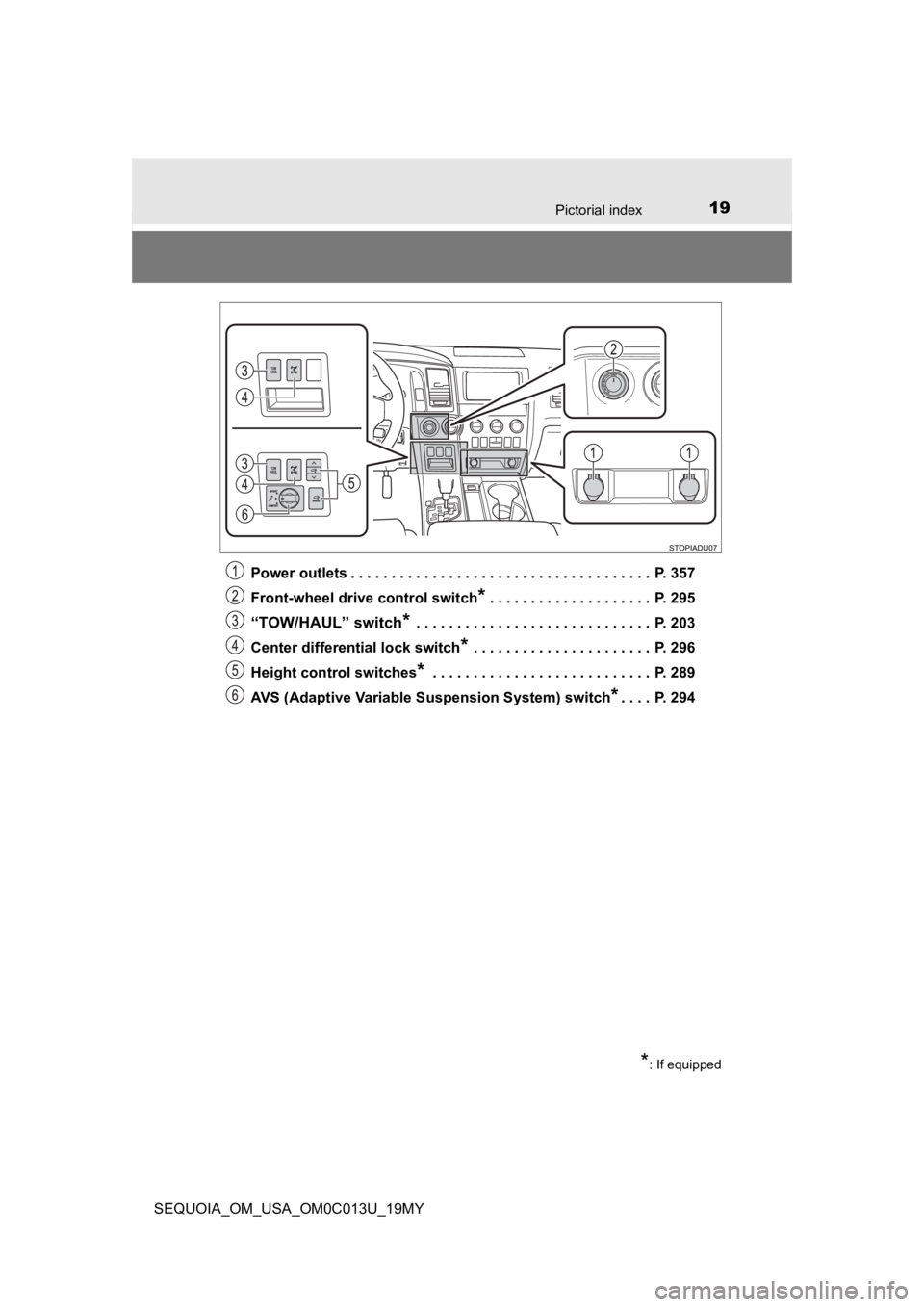
19Pictorial index
SEQUOIA_OM_USA_OM0C013U_19MYPower outlets . . . . . . . . . . . . . . . . . . . . . . . . . . . . . . . . . . . . . P. 357
Front-wheel drive
control switch
* . . . . . . . . . . . . . . . . . . . . P. 295
“TOW/HAUL” switch* . . . . . . . . . . . . . . . . . . . . . . . . . . . . . P. 2 03
Center differential lock switch
* . . . . . . . . . . . . . . . . . . . . . . P. 296
Height control switches
* . . . . . . . . . . . . . . . . . . . . . . . . . . . P. 289
AVS (Adaptive Variable Suspension System) switch
*. . . . P. 294
*: If equipped
Page 31 of 560

311-1. For safe use
1
For safety and security
SEQUOIA_OM_USA_OM0C013U_19MY
Push the seat belt shoulder
anchor down while pressing the
release button.
Push the seat belt shoulder
anchor up.
Move the height adjuster up and
down as needed until you hear a
click.
The pretensioners help the seat
belts to quickly restrain the occu-
pants by retracting the seat belts
when the vehicle is subjected to
certain types of severe frontal or
side collision, or a vehicle rollover.
The pretensioners do not activate
in the event of a minor frontal
impact, a minor side impact or a
rear impact.
Adjusting the seat belt shoulder anchor height (front and second
outer seats)
Seat belt pretensioners (front seats)
Page 120 of 560
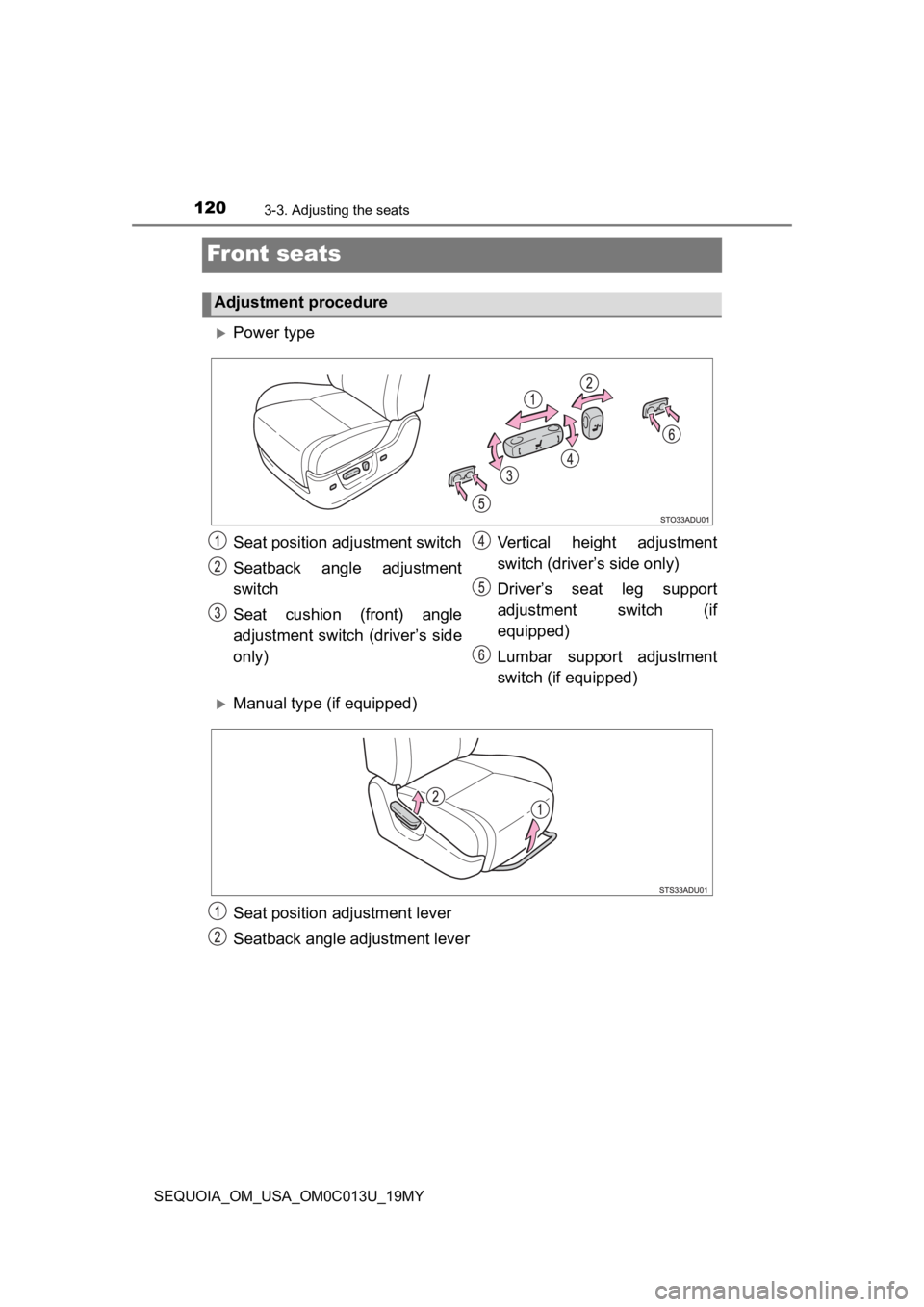
1203-3. Adjusting the seats
SEQUOIA_OM_USA_OM0C013U_19MY
Front seats
Adjustment procedure
Power type
Seat position adjustment switch
Seatback angle adjustment
switch
Seat cushion (front) angle
adjustment switch (driver’s side
only) Vertical height adjustment
switch (driver’s side only)
Driver’s seat leg support
adjustment switch (if
equipped)
Lumbar support adjustment
switch (if equipped)
Manual type (if equipped)
Seat position adjustment lever
Seatback angle
adjustment lever
Page 139 of 560
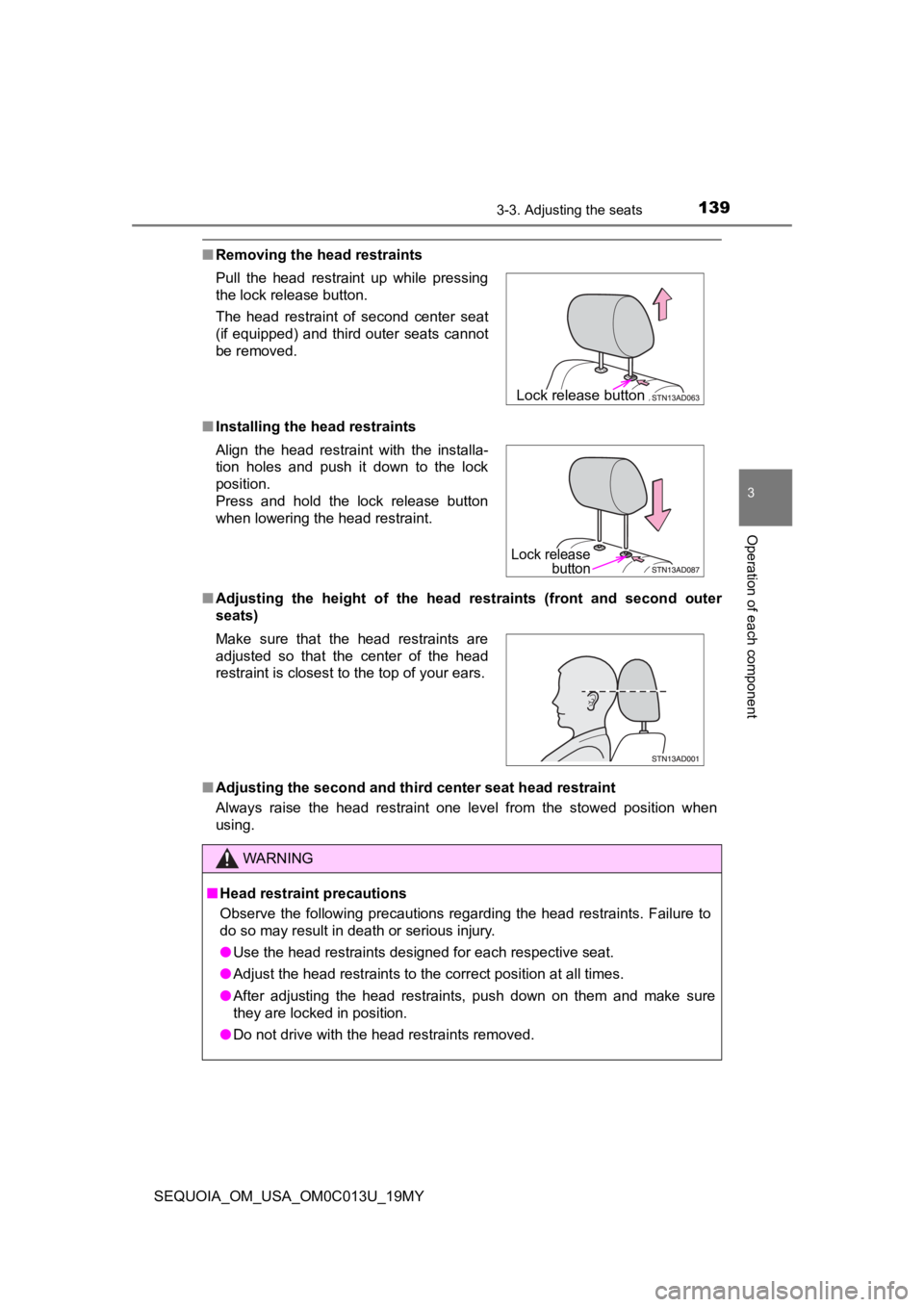
1393-3. Adjusting the seats
3
Operation of each component
SEQUOIA_OM_USA_OM0C013U_19MY
■Removing the head restraints
■ Installing the head restraints
■ Adjusting the height of the head restraints (front and second o uter
seats)
■ Adjusting the second and thir d center seat head restraint
Always raise the head restraint one level from the stowed position when
using. Pull the head restraint up while pressing
the lock release button.
The head restraint of second center seat
(if equipped) and third outer seats cannot
be removed.
Align the head restraint with the installa-
tion holes and push it down to the lock
position.
Press and hold the lock release button
when lowering the head restraint.
Make sure that the head restraints are
adjusted so that the center of the head
restraint is closest to the top of your ears.
WARNING
■ Head restraint precautions
Observe the following precautions regarding the head restraints. Failure to
do so may result in death or serious injury.
● Use the head restraints designed for each respective seat.
● Adjust the head restraints to the correct position at all times.
● After adjusting the head restraints, push down on them and make sure
they are locked in position.
● Do not drive with the head restraints removed.
Lock release button
Lock releasebutton
Page 142 of 560
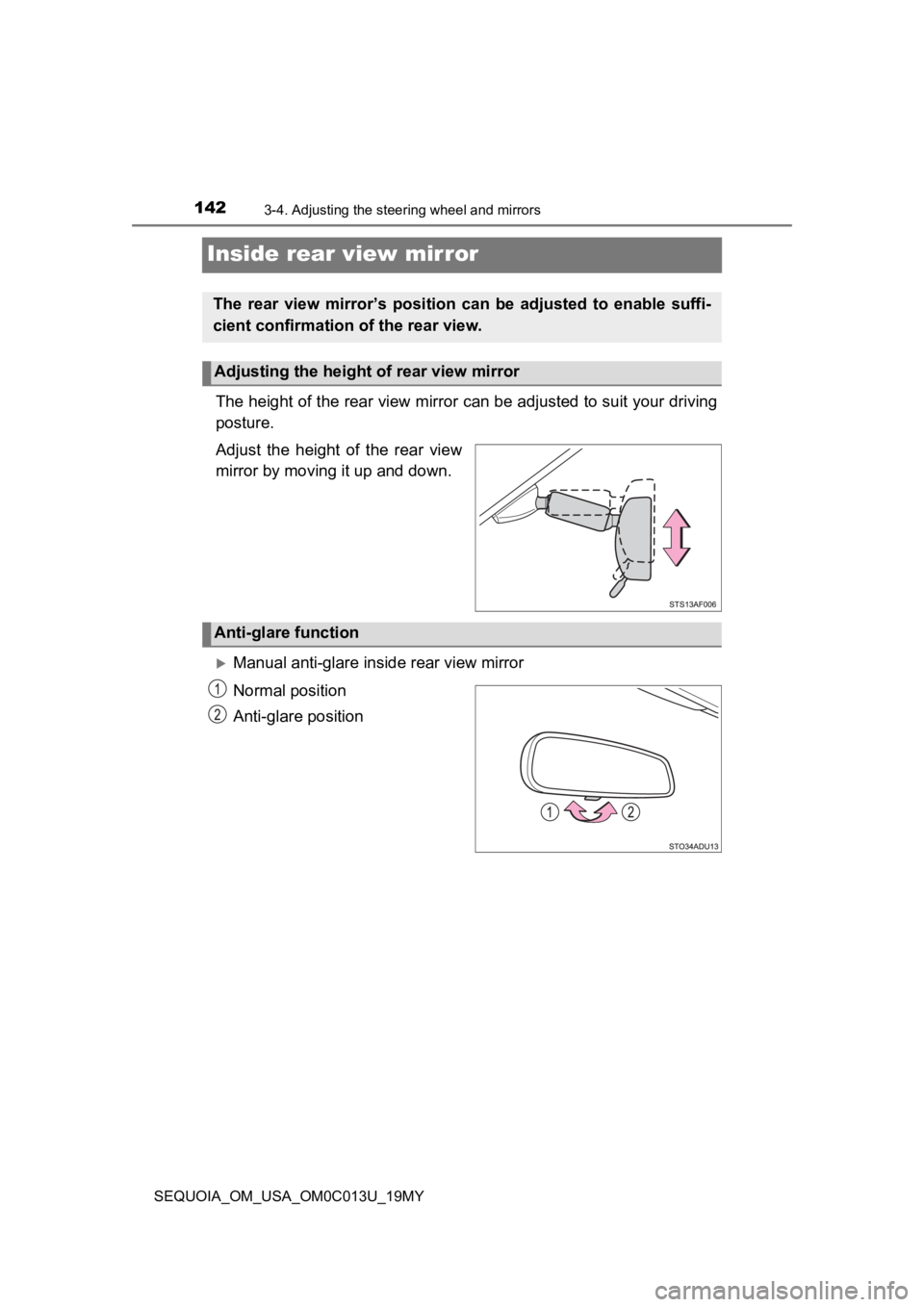
1423-4. Adjusting the steering wheel and mirrors
SEQUOIA_OM_USA_OM0C013U_19MY
Inside rear view mirror
The height of the rear view mirror can be adjusted to suit your driving
posture.
Adjust the height of the rear view
mirror by moving it up and down.
Manual anti-glare inside rear view mirror
Normal position
Anti-glare position
The rear view mirror’s position ca n be adjusted to enable suffi-
cient confirmation of the rear view.
Adjusting the height of rear view mirror
Anti-glare function
Page 164 of 560

1644-1. Before driving
SEQUOIA_OM_USA_OM0C013U_19MY
WARNING
Observe the following precautions.
Failure to do so may result in death or serious injury.
■When driving the vehicle
● During normal driving, do not turn off the engine. Turning the engine off
while driving will not cause loss of steering or braking control, but the
power assist to these systems will be lost. This will make it more difficult to
steer and brake, so you should pull over and stop the vehicle as soon as it
is safe to do so.
However, in the event of an emergency, such as if it becomes im possible
to stop the vehicle in the normal way: P. 439
● Use engine braking (downshift) to maintain a safe speed when driving
down a steep hill.
Using the brakes continuously may cause the brakes to overheat and lose
effectiveness. ( P. 201)
● Do not adjust the positions of the steering wheel, the seat, or the inside or
outside rear view mirrors while driving.
Doing so may result in a loss of vehicle control.
● Always check that all passengers’ arms, heads or other parts of their body
are not outside the vehicle.
● Do not drive in excess of the speed limit. Even if the legal sp eed limit per-
mits it, do not drive over 85 mph (140 km/h) unless your vehicl e has high-
speed capability tires. Driving over 85 mph (140 km/h) may resu lt in tire
failure, loss of control and possible injury. Be sure to consult a tire dealer
to determine whether the tires on your vehicle are high-speed capability
tires or not before driving at such speeds.
● On vehicles with electronically modulated air suspension, if you drive
through deep water over about 20 in. (500 mm) in depth, put the vehicle
height in the “HI” mode using the height control switch and the n change to
manual mode by pushing the height control mode select switch. Drive your
vehicle at 18 mph (30 km/h) or less. Do not drive through water deeper
than about 28 in. (700 mm) even if the vehicle height is in “HI” mode.
Page 184 of 560
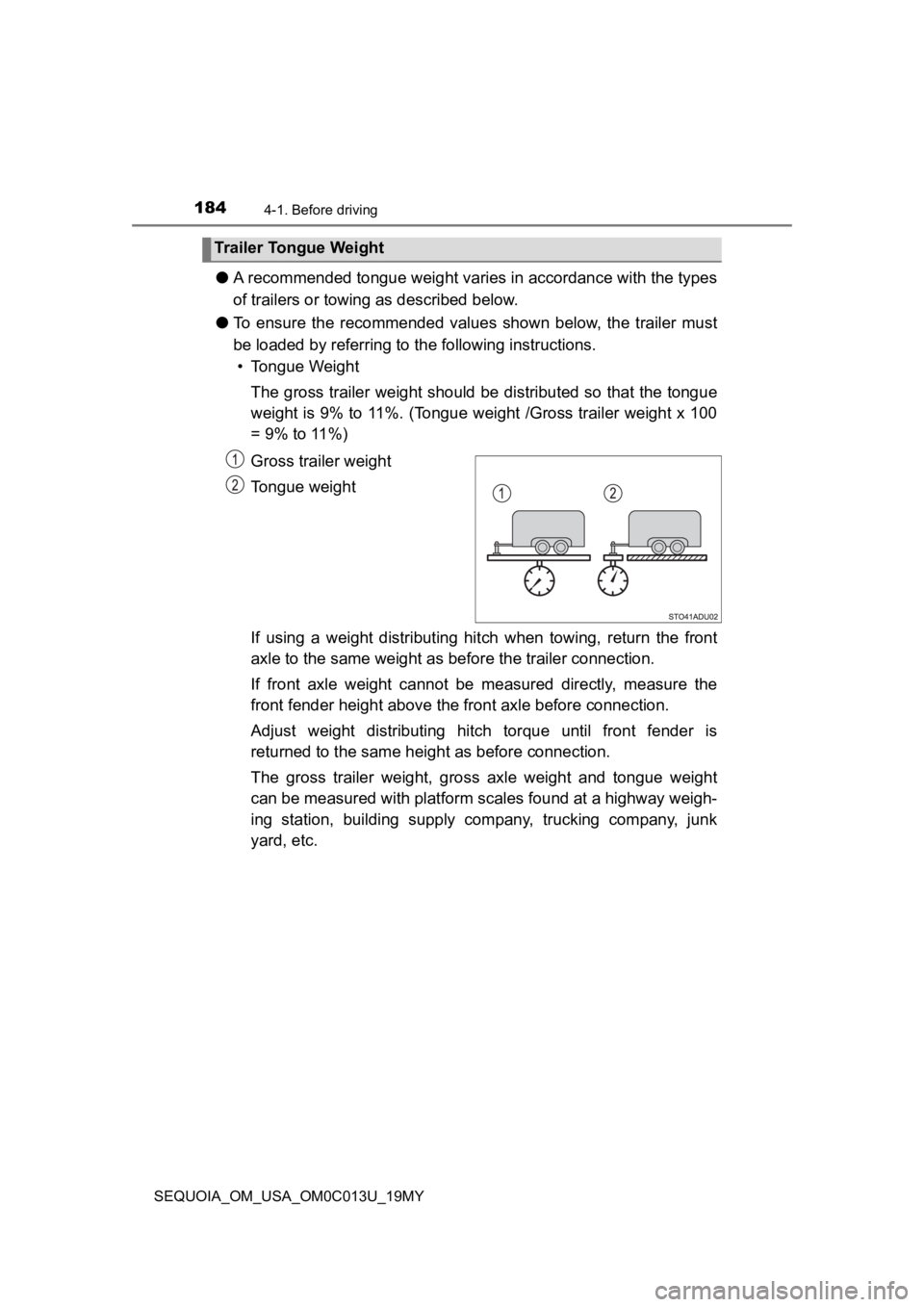
1844-1. Before driving
SEQUOIA_OM_USA_OM0C013U_19MY
●A recommended tongue weight varies in accordance with the types
of trailers or towing as described below.
● To ensure the recommended values shown below, the trailer must
be loaded by referring to t he following instructions.
• Tongue Weight
The gross trailer weight should be distributed so that the tong ue
weight is 9% to 11%. (Tongue weight /Gross trailer weight x 100
= 9% to 11%)
Gross trailer weight
Tongue weight
If using a weight distributing hi tch when towing, return the front
axle to the same weight as b efore the trailer connection.
If front axle weight cannot be measured directly, measure the
front fender height above the fr ont axle before connection.
Adjust weight distributing hitch torque until front fender is
returned to the same hei ght as before connection.
The gross trailer weight, gross axle weight and tongue weight
can be measured with platform sca les found at a highway weigh-
ing station, building supply company, trucking company, junk
yard, etc.
Trailer Tongue Weight
Page 188 of 560

1884-1. Before driving
SEQUOIA_OM_USA_OM0C013U_19MY
If a height control system is installed in your vehicle, you have to con-
nect and disconnect your trailer more carefully.
● Connecting
Set the height control of electronically modulated air suspensi on
system to “N” mode.
Turn off the engine, or set the electronically modulated air su spen-
sion system to manual mode. ( P. 290)
Connect the trailer.
Turn the engine switch to the “START” position and start the
engine.
Press the height control mode select switch to cancel the manua l
mode condition that was set on step .
Check that the “OFF” i ndicator turns off.
Set the height control of electronically modulated air suspensi on
system to “N” mode.
● Disconnecting
Set the height control of electronically modulated air suspensi on
system to “N” mode.
Set the electronically modulat ed air suspension system to manua l
mode.
Turn off the engine.
Set the supporting leg of the trailer on the ground and raise t he
hitch by 4 in. (100 mm).
Turn the engine switch to the “START” position and start the
engine.
Press the height control mode select switch to cancel the manua l
mode condition that was set on step .
Check that the “OFF” i ndicator turns off.
Wait until vehicle h eight is stabilized.
Make sure the hitch is disconnected. If the hitch does not disc on-
nect, raise the hitch higher and repeat steps through .
Move the vehicle forward in “LO” mode where the hitch does not touch
anything in “N” mode.
Set the height control of electronically modulated air suspensi on system to
“N” mode.
Connecting and disconnecting a trailer (vehicles with electroni -
cally modulated air suspension)
1
2
3
4
5
2
6
1
2
3
4
5
6
2
7
8
27
Page 191 of 560
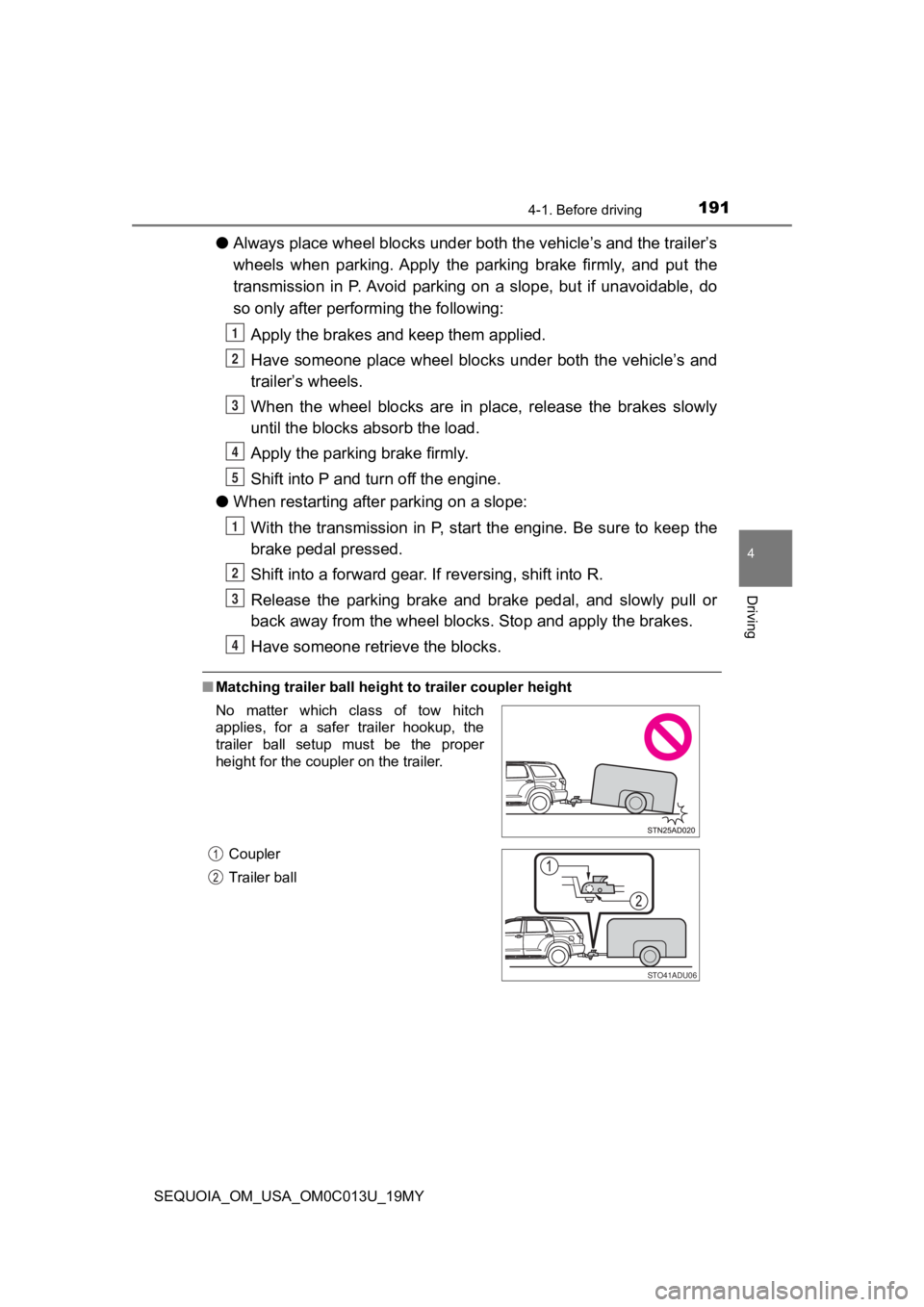
1914-1. Before driving
4
Driving
SEQUOIA_OM_USA_OM0C013U_19MY
●Always place wheel blocks under both the vehicle’s and the trai ler’s
wheels when parking. Apply the parking brake firmly, and put th e
transmission in P. Avoid parking on a slope, but if unavoidable , do
so only after perform ing the following:
Apply the brakes and keep them applied.
Have someone place wheel blocks under both the vehicle’s and
trailer’s wheels.
When the wheel blocks are in pl ace, release the brakes slowly
until the blocks absorb the load.
Apply the parking brake firmly.
Shift into P and turn off the engine.
● When restarting afte r parking on a slope:
With the transmission in P, start the engine. Be sure to keep t he
brake pedal pressed.
Shift into a forward gear. If reversing, shift into R.
Release the parking brake and brake pedal, and slowly pull or
back away from the wheel bloc ks. Stop and apply the brakes.
Have someone retrieve the blocks.
■ Matching trailer ball height to trailer coupler height
1
2
3
4
5
1
2
3
4
No matter which class of tow hitch
applies, for a safer trailer hookup, the
trailer ball setup must be the proper
height for the coupler on the trailer.
Coupler
Trailer ball
STO41ADU06
Page 192 of 560

1924-1. Before driving
SEQUOIA_OM_USA_OM0C013U_19MY■
Before towing
Check that the following conditions are met:
●Ensure that your vehicle’s tires are properly inflated. ( P. 499)
● Trailer tires are inflated according to the trailer manufacture r’s recommen-
dation.
● All trailer lights work as required by law.
● All lights work each time you connect them.
● The trailer ball is set at the proper height for the coupler on the trailer.
● The trailer is level when it is hitched.
Do not drive if the trailer is not level, and check for imprope r tongue weight,
overloading, worn suspension, or other possible causes.
● The trailer cargo is securely loaded.
● The rear view mirrors conform to all applicable federal, state/provincial or
local regulations. If they do not, install rear view mirrors ap propriate for tow-
ing purposes.
● Depress “TOW/HAUL” button (if equipped)
■ AVS (adaptive variable suspension system) (if equipped)
The suspension can be switched for improvement in drivability. (P. 294)
■ Break-in schedule
If your vehicle is new or equipped with any new power train com ponents
(such as an engine, transmission, differential or wheel bearing ), Toyota rec-
ommends that you do not tow a trailer until the vehicle has bee n driven for
over 500 miles (800 km).
After the vehicle has been driven for over 500 miles (800 km), you can start
towing. However, for the next 500 miles (800 km), drive the veh icle at a speed
of less than 50 mph (80 km/h) when towing a trailer, and avoid full throttle
acceleration.
■ Maintenance
●If you tow a trailer, your vehicle will require more frequent m aintenance due
to the additional load. (See “Scheduled Maintenance Guide” or “ Owner’s
Manual Supplement”.)
● Retighten the fixing bolts of the towing ball and bracket after approximately
600 miles (1000 km) of trailer towing.